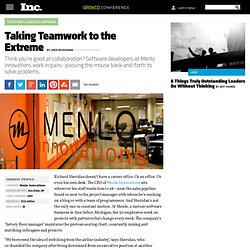Design Thinking Action Lab
Use our methods. DP0 (Design Project Zero) is a 90-minute (including debrief) fast-paced project though a full design cycle.

Students pair up to interview each other, create a point-of-view, ideate, and make a new solution that is “useful and meaningful” to their partner. Two versions of DP0 are “The Wallet Project” and “The Gift-Giving Project”. They have the similar format, only the topic is different. The original DP0 The Wallet Project was created for the d.school’s very first course in 2004 and the project starts with students looking at the content of their partner’s wallet or purse (and goes on to ask every student to design something for their partner).
Another DP0 topic is The Gift-Giving Project where students are asked to redesign how their partner gives gifts. Get the materials to facilitate the activity for a group yourself here.
Design Thinking for Educators. METHODCARDS2010pagenumbers.pptx. Extreme By Design clip # 2: Learning by doing. Sparks Fly - March/April 2011. Can imagination be taught?

Evidently, because the d.school’s innovation hothouse is changing the way people think. A first-year graduate student in the management science and engineering program, Asha Gupta had barely started Design Garage, a course aptly characterized as an "imagination dunk tank"—and she was getting soaked. Gupta and her classmates were challenged to develop a prototype that would improve the gift-giving experience. They had 54 minutes.
The students—an eclectic group with a budding musicologist, a neuroscientist, a journalist and two future lawyers—paired off to interview each other about anything that made them unhappy when giving gifts. "Ah, so the gift involves magic!
" In nine rapid-fire stages, the students lobbed questions, exchanged answers, sketched out multiple solutions and then frenetically hacked together crude 3D mockups from materials seemingly stolen from a kindergarten playroom: pipe cleaners, yarn, spaghetti, glue, aluminum foil, construction paper.
Tom Kelley, IDEO - Young at Heart: How to Be an Innovator for Life. The Ten Faces of Innovation » The Ten Faces. The Learning Personas Individuals and organizations need to constantly gather new sources of information in order to expand their knowledge and grow, so the first three personas are learning roles.

These personas are driven by the idea that no matter how successful a company currently is, no one can afford to be complacent. The world is changing at an accelerated pace, and today's great idea may be tomorrow's anachronism. The learning roles help keep your team from becoming too internally focused, and remind the organization not to be so smug about what you “know”. People who adopt the learning roles are humble enough to question their own worldview, and in doing so they remain open to new insights every day. The Anthropologist is rarely stationary. The Experimenter celebrates the process, not the tool, testing and retesting potential scenarios to make ideas tangible.
Most Audacious Companies: Menlo Innovations. Richard Sheridan doesn’t have a corner office.

Or an office. Or even his own desk. The CEO of Menlo Innovations sits wherever his staff wants him to sit--near the sales pipeline board or next to the project manager with whom he’s working on a blog or with a team of programmers. And Sheridan’s not the only one in constant motion. At Menlo, a custom-software business in Ann Arbor, Michigan, the 50 employees work on projects with partners that change every week. "We borrowed the idea of switching from the airline industry," says Sheridan, who co-founded the company after being downsized from an executive position at another technology firm. The practice also builds in perpetual learning as employees effectively mentor each other all the time. The variety of partners and tasks also keeps employees from burning out on projects that sometimes roll out over years. Menlo’s feedback system further reinforces the collaborative model.
Stanford d.school - case study. The Context of the Innovator: Process.
The Context of the Innovator: People. The Context of the Innovator: Space. The Mindset of the Innovator. PROCESS 1)




